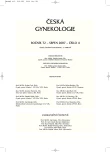Maternal Position at the Delivery and Perineal Trauma
Authors:
V. Kališ; J. Štěpán jr.; M. Králíčková; P. Žlůvová; Z. Rokyta
Authors‘ workplace:
Gynekologicko-porodnická klinika LF UK a FN Plzeň, přednosta doc. MUDr. Z. Rokyta, CSc.
Published in:
Ceska Gynekol 2007; 72(4): 241-246
Category:
Original Article
Overview
Objective:
Summary of the relation between of maternal position at the delivery and obstetrical perineal trauma.
Design:
Review.
Setting:
Department of Gynaecology and Obstetrics, Charles University and Faculty Hospital Plzen.
Summary:
Positions of mother at the delivery are divided in to: supine, semi-recumbent, lithotomy, lateral and upright positions – standing, sitting, squatting and kneeling. Birthing chair or stool might be applied. Outlined potential benefit of upright positions.
So far there was not observed any consented negative impact of upright position on a mother or a child. Its potential positive effect has not been proved. A reduction of episiotomy, a slight increase in the second degree tears and more frequent blood lost over 500mls has been described. The risk of anal sphincter trauma has been studied insufficiently. It appears, the different positions might involve different risks of the third degree tear. Up to now there is no reason to discourage woman from some of upright positions. Anyway she must be fully informed of a limited support and protection of perineum in an effort to reduce the risk of anal sphincter injury.
Key words:
delivery, upright, anal sphincter, perineum, anal incontinence, perineal trauma, third degree tear, episiotomy
Labels
Paediatric gynaecology Gynaecology and obstetrics Reproduction medicineArticle was published in
Czech Gynaecology

2007 Issue 4
Most read in this issue
- Maternal Position at the Delivery and Perineal Trauma
- Prediction of Intrauterine Growth Retardation Using the Integrated Test Markers
- The Science-Meter Indicators (Citation index, Impact factor, Hirsch-index) and the Evaluation of the Scientific Activity in Medicine
- Occult Anal Sphincter Tear – Up-to-date Knowledge
